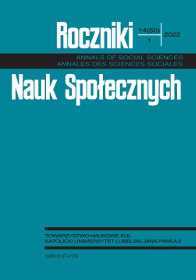Recovery Plan for Europe as a Strenghtening of Social Security for European Union Citizens After the COVID-19 Pandemic
Abstract
Sustainable development and environmental protection, health protection, human rights, aging societies and combating social risks are relevant issues in the European Union. The EU’s actions in the sphere of social security became even more important after the outbreak of the COVID-19 pandemic. Countries around the world faced the specter of an economic crisis associated with lockdowns on the one hand, and a crisis in health care and the need to reorganize the health security of citizens on the other. Mitigating the health crisis and tackling the adverse effects of the economic collapse have become priorities for the European Union, which in its Recovery Plan for Europe and its main component, Next Generation EU, has paid particular attention to green and digital transformation, health security, and rebuilding economic potential, especially the potential of small and medium-sized enterprises
References
Annan K. A. (2000), We the Peoples. The Role of The United Nations in the 21st Century, New York: United Nations Department of Public Information, https://www.un.org/en/events/pastevents/pdfs/We_The_Peoples.pdf, s. 23 [dostęp: 29.03.2022].
BMF (2021), Deutscher Aufbau- und Resilienzplan, Bundesministerium der Finanzen, https://www.bundesfinanzministerium.de/Content/DE/Standardartikel/Themen/Europa/DARP/1-allgemeine-ziele-und-kohaerenz.pdf?__blob=publicationFile&v=6 [dostęp: 12.02.2022].
Czarnecki S. (2020), Czeska gospodarka w obliczu pandemii COVID-19, https://ies.lublin.pl/komentarze/czeska-gospodarka-w-obliczu-pandemii-covid-19 [dostęp: 12.02.2022].
ECDC (2021), COVID-19 situation update for EU, European Centre for Disease Prevention and Control, https://www.ecdc.europa.eu/en/cases-2019-ncov-eueea [dostęp: 10.02.2022].
EEAS (2016), Wspólna wizja, Wspólne działanie: Silniejsza Europa. Globalna strategia na rzecz polityki zagranicznej i bezpieczeństwa Unii Europejskiej, European External Action Service, http://eeas.europa.eu/archives/docs/top_stories/pdf/eugs_pl_.pdf [dostęp: 21.02.2022].
Eurostat (2021), GDP and main components, https://ec.europa.eu/eurostat/databrowser/view/NAMQ_10_GDP__custom_77309/bookmark/map?lang=en&bookmarkId=b74febcd-e664-4f22-9c93-2ef510fe371f) [dostęp: 15.02.2022].
Gierszewski J. (2013), Bezpieczeństwo społeczne. Studium z zakresu teorii bezpieczeństwa narodowego, Warszawa: Difin, s. 165.
GOB (2021), Plan de Recuperation, Transformation y Resiliencia, Gobierno de España, https://www.lamoncloa.gob.es/temas/fondos-recuperacion/Documents/160621-Plan_Recuperacion_Transformacion_Resiliencia.pdf [dostęp: 10.02.2022].
Karta Praw Podstawowych Unii Europejskiej, Dz. Urz. UE 2012/C 326/02, https://eur-lex.europa.eu/legal-content/PL/TXT/PDF/?uri=CELEX:12012P/TXT&from=PL [dostęp: 21.02.2022].
KE (2017), Dokument dotyczący społecznego wymiaru Unii Europejskiej, Komisja Europejska, https://ec.europa.eu/commission/sites/beta-political/files/reflection-paper-social-dimension-europe_pl.pdf [dostęp: 20.02.2022].
KE (2021), European Pillar of Social Rights Action Plan, Komisja Europejska, https://ec.europa.eu/info/strategy/priorities-2019-2024/economy-works-people/jobs-growth-and-investment/european- pillar-social-rights/european-pillar-social-rights-action-plan_en#documents [dostęp: 13.02.2022].
Leszczyński M. (2012), Wybrane obszary zagrożeń dla rozwoju społecznoekonomicznego i bezpieczeństwa społecznego, w: B. Bakalarz-Kowalska (red.), Acta Scientifica Academiae Ostroviensis. Sectio A, Nauki Humanistyczne, Społeczne i Techniczne, Ostrowiec Świętokrzyski: Wyższa Szkoła Biznesu i Przedsiębiorczości w Ostrowcu Św., s. 55.
LRFM (2021), Ekonomikos gaivinimo ir atsparumo didinimo plana „Naujos Kartos Lietuva”, Lietuvos Respublikos finansų ministeria, https://finmin.lrv.lt/uploads/finmin/documents/files/ Naujos%20kartos%20Lietuva%20planas.pdf [dostęp: 14.02.2022].
MEF (2021), Piano nazionale di ripresa e resilenza, Ministero dell’Economia e delle Finanze, https://www.mef.gov.it/focus/Il-Piano-Nazionale-di-Ripresa-e-Resilienza-PNRR [dostęp: 12.02.2022].
Narodni plan obnowy (2021), https://www.planobnovycr.cz/dokumenty [dostęp: 13.02.2022].
PE, Rada UE (2021), Rozporządzenie Parlamentu Europejskiego i Rady 2021/241 z 12 lutego 2021 r. ustanawiające Instrument na rzecz Odbudowy i Zwiększania Odporności, Dz. Urz. UE L 57 18.2.2021, Parlament Europejski, https://eur-lex.europa.eu/legal-content/PL/TXT/HTML/?uri =CELEX:32021R0241&from=EN [dostęp: 10.02.2022].
RE, Rada UE (2021), Plan Odbudowy dla Europy, Rada Europejska, Rada Unii Europejskiej, https://www.consilium.europa.eu/pl/policies/eu-recovery-plan [dostęp: 16.02.2022].
Rosik P. (2021), Niemcy po pandemii i rządach Merkel. Oto najnowsze prognozy, Forsal.pl (data dodania: 26.10.2021), https://forsal.pl/gospodarka/artykuly/8278486,niemcy-po-pandemii-i-rzadach-merkel-najnowsze-prognozy.html [dostęp: 12.02.2022].
Rysz-Kowalczyk B. (red.) (2021), Leksykon Polityki Społecznej, Warszawa: Oficyna Wydawnicza Aspra-JR, s. 57.
Trusewicz I. (2021), Moody’s chwali Litwę, Rzeczpospolita.pl (data dodania: 2.03.2021), https://www.rp.pl/gospodarka/art249061-moody-s-chwali-litwe-najlepiej-poradzila-sobie-z-pandemia [dostęp: 13.02.2022].
UE (2010), Projekt Europa 2030. Wyzwania i szanse. Sprawozdanie dla Rady Europejskiej sporządzone przez Grupę Refleksji dotyczące przyszłości UE do 2030 roku, Unia Europejska, https://www.consilium.europa.eu/media/30767/qc3210249plc.pdf [dostęp: 15.02.2022].
Wysocka S. (2022), Włoski wiceminister zdrowia: Omikron dosięgnie prawie wszystkich, GazetaPrawna.pl (data dodania: 16.01.2022), https://serwisy.gazetaprawna.pl/zdrowie/artykuly/8334294,wiceminister-zdrowia-wlochy-omikron.html [dostęp: 20.02.2022].
Copyright (c) 2022 Roczniki Nauk Społecznych

This work is licensed under a Creative Commons Attribution-NonCommercial-NoDerivatives 4.0 International License.


